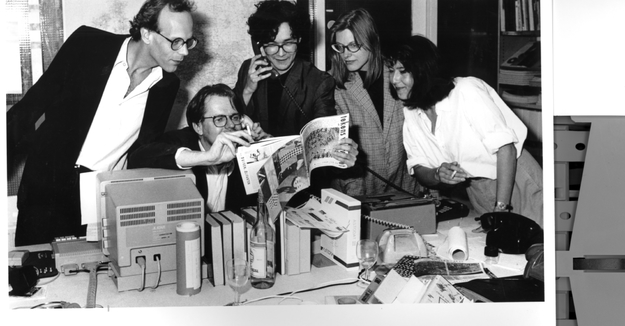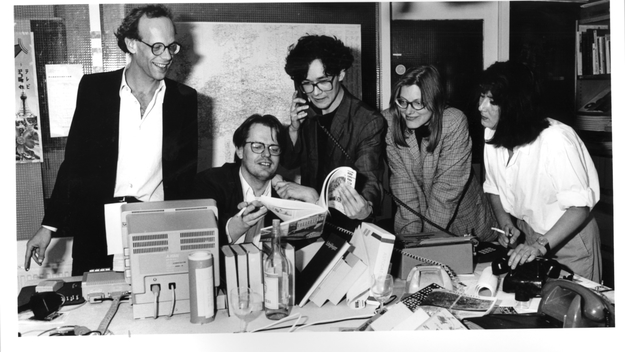Could you describe the start of Mediamatic?
Mediamatic was founded by a group of people, some of them artists and some of them were involved in supporting the arts. At that time there was a need for support for media artists because they used technologies that were hard to get and expensive to use. So we founded Mediamatic as a sort of informal collective to help with the production and presentation of media art. This was in the summer of 1983. I (Willem) was at that time studying art history at the university of Groningen and had a job managing the video-editing studio of the art-history institute. I had the key to the editing studio. So it was nice to use the downtime of the studio at night to help artists make their work.
What about the magazine?
Jans and I started the magazine a few years later. We were both studying art history for already 4 or 5 years then, so we were quite at home with talking and writing about art. And I (Willem) already graduated as a graphic designer, so making printed matter was also known territory. We needed a good platform for intellectual exchange about what we were doing; helping artist make things and presenting media art. After a while we learned that we wanted to have a better way of thinking and talking about it. Now a days you can just start a blog. But we couldn't, so we made a magazine. And we asked our friends to help.
How did you come up with the themes for the different magazines?
The themes came later, first we just made the first issue to see what would happen. There was a festival happening at that time, called Talking back to the Media. It was a festival on media art and artist reflecting on what media was doing. We launched the magazine there. The people reacted very positively because something like that wasn’t around yet. So that was very encouraging.
How did you get funding?
We first made the zero issue and sent it to the ministry of culture for approval and then got money to make 4 issues. It wasn’t a lot of money. We started to ask people to help with the distribution. We made the magazine in English right away because the subject of the magazine was a niche and there were not enough people in the Netherlands who were interested in this topic. Besides, there was no other country that did something like us. We all made the magazine next to our normal jobs, because it did not make a lot of money. But it was fun to do it. And it was really nice to do it next to organizing events.
How did people talk about Mediamatic Magazine when it first came out?
People thought is was real, but for us it was just something we made. It’s not an authority if you make it with your own hands. You sit and be like, ok we are just going to interview some people and write something about art. We just made the whole thing into something that looks like a real magazine. But actually we know that it’s not real. It’s just us making it. We're making it up, we’re just playing as if we are making a magazine. So we had this un-official feeling. But of course it looks real. And some of the stuff we published is also interesting. So people started respecting it, and started to respect us to be official, to be an institution. We were just doing it, and if you wanted to join in, just could just do it, you know, that wasn't a problem. But from the outside it looks like a closed thing.
Was Mediamatic Magazine popular abroad?
Popular is a very big word for something that had no bigger print than 5000 copies. I think one time we had printed 5000 copies and it was sold out so we had to print more. But beside that there never have been more than 5000 copies. But for some people it was very special. We worked quit hard on it. We had a distributor in New York and in London who helped spread the magazine to the best bookstores in their countries. We also used to make our own press-passes, to get in at festivals and museums for free. We did not have money to pay our editors, but they had these kind of perks and they got a few extra prints to give away. And because we where the only platform it was also good publicity for them. So we were growing a network slowly.
How did you come up with the name 'Mediamatic'?
It comes from a discussion we had in a café. If you look at our first logo it was a little bit like the logo of the 'variomatic'. They have this 1950’s typography. It was sort of a way to make a joke about modernism, and future technology. And also something –matic was used for automatic things. So it's actually an old-fashioned way to talk about machines. I (Willem) was against this name. I am not sure who mentioned it first, may have been me. But some others really liked it. And there was no other alternative.
Could you tell us something about Mediamatic Off-Line?
In 1999 we started publishing online and stopped printing. But we still had something quite valuable. We had a sort of functioning distribution for paper magazines. If you make an independent artist CD-ROM, publish it yourself and then sell it in a bookstore, it's almost impossible. You have to go to all these bookstores to present your work and they have to order it. It's super difficult. People were also still paying for their subscription. So we thought ok…, if we find an artist CD-ROM that we want to publish, we just do it. We make a thin cover with a description. And we just use the old distribution network. And it was called Mediamatic Off-Line because that was the time we went online. Eventually we stopped doing it, because these relationships with distributers and subscribers they just died. They don’t know us anymore.
